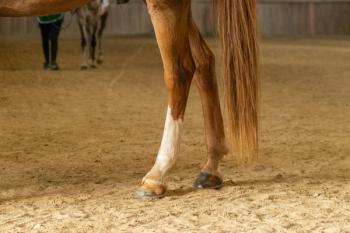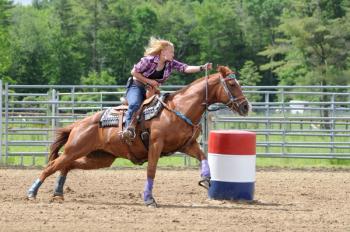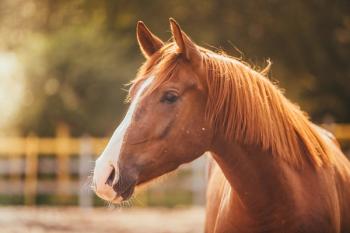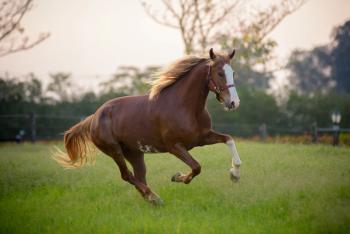
Diagnosis of palmar foot lameness (Proceedings)
Those structures that can be associated with lameness: hoof, synovial structures, bone, tendons, ligaments.
Anatomy of the Palmar Foot
• Those structures that can be associated with lameness:
o Hoof
• Digital cushion
• Collateral cartilages
• Frog
• Heels
• Sole
o Synovial structures
• Coffin joint
• Navicular bursa
• Digital sheath
o Bone
• P2
• P3
• Navicular
o Tendons
• Deep digital flexor
o Ligaments
• Impar
• Suspensory ligament of the navicular
• Distal digital annular ligament
• Collateral ligaments of the distal interphalangeal joint
The Foot
• Diagnostics - localization
o Peri-neural anesthesia
• Palmar digital nerve block
• Dorsal branches
• Abaxial sesamoid nerve block
o Intra-synovial
• Coffin joint
• Navicular bursa
• Digital sheath
• Palmar digital nerve block
o 1.5 – 2 ml of anesthetic
o Placed over neurovascular bundle
o Just axial to collateral cartilages
o Desensitizes ⅓ to ½ of the foot
o Structures blocked: (Stashak TS Adams Lameness in Horses pp 162)
• Navicular bone
• Navicular bursa
• Navicular apparatus
• Distal sesamoidean ligaments
• DDFT, SDFT
• Digital sheath
• Digital cushion
• Frog
• Sole
• Palmar coffin joint
• Palmar ⅓ and distal aspect of P3
• Dorsal branches – pastern ring block
o 3 to 5 ml anesthetic
o Just proximal to collateral cartilages
o Directed dorsally
o Structures blocked
• Coffin joint
• Pastern joint
• Remainder of P3
• Remainder of sole
• P2
• Abaxial-sesamoid nerve block
o 2 – 3 ml anesthetic
o Placed over neurovascular bundle at base of the proximal sesamoids
o Structures blocked (in addition to those with PD)
• Coffin joint
• Pastern joint
• Palmar fetlock joint (variable)
• Remainder of P3
• Remainder of sole
• P2
• Intra-synovial anesthesia
o Coffin joint
• 3 techniques
• Dorsal-lateral
o 1 cm above coronary band
o 1.5 cm lateral to midline
o Needle inserted at 90º angle to bottom of foot
• Dorsal
o Through the common digital extensor
o Needle angled just distal to horizontal
• Lateral (palmar pouch)
o Distal palmar border of the middle phalanx and notch in lateral cartilage
o Needle inserted laterally in dorso-medial direction
o Navicular bursa
• 5 techniques (Schramme et al EVJ 2000 32:263)
o Digital sheath
• 3 techniques
• Proximo-lateral pouch
o 1 cm proximal to the annular ligament
o 1 cm palmar to the lateral branch of the suspensory ligament
o Direct needle slightly distal
• Base of sesamoid
o Axial to the midbody of the sesamoid
o Leg flexed 225º
o Needle inserted 3mm axial to the border of the midbody
o Directed 45º to the sagittal plane 1.5 – 2 cm
• Pastern region
o Outpouching of sheath between proximal and distal annular ligaments
o Do these provide specific anesthesia only to these structures?
• Coffin joint
• Palmar pouch is close to digital nerves
• Anesthetic diffuses to navicular bursa and to a lesser extent the navicular bone (Keegan KG et al AJVR 2006 57:422)
• Recommendations:
o Use 6 ml of anesthetic
o Observe after 5 minutes
• Navicular bursa
• Palmar digital nerves are in close proximity to the navicular bursa (Bowker RM et al AAEP Proc 1996: 33-47)
• Also blocking other palmar structures?
• Diffusion between DIP joint and bursa
o Quite variable (Bowker RM et al JAVMA 1993 203:1708-1714)
o Less from bursa to DIP than reverse (Gough MR et al EVJ 2002 34:80-84)
• Eliminated solar toe pain in one study (Schumacher J et al EVJ 2001 33:386-89)
• After 20 minutes: improved coffin joint-associated lameness (Schumacher J et al EVJ 2003 35(5) 502-505)
• If within 20 minutes then more specific for bursa and associated structures
• Recommendations
o Inject using distal palmar approach with radiographic guidance
o 3 – 4 ml of anesthetic
• Observe lameness in 10 minutes
• Digital sheath
• Analgesia is specific for the structures within the digital sheath using the palmar-axial sesamoidean technique (Harper J et al EVJ 2007 39(6):535-539)
• Blocking structures associated with the sheath
o DDFT
o Distal sesamoidean ligaments
o SDFT
o Palmar annular ligament of the fetlock
o Digital annular ligament
• Recommendations:
o Anesthesia is specific
o Use as described
• Diagnostic imaging
o Radiographic exam
• Views:
• Lateral
• DP navicular
• DP P3
• Skyline navicular
• Optional:
o DP oblique P3
• Radiographic grading of navicular changes* (Dyson SJ: Diagnosis and Management of Lameness in the Horse; pp 293)
• 0: Excellent
o Good corticomedullary demarcation
o Fine trabecular pattern
o Flexor cortex of uniform thickness
o No synovial invaginations along distal border or fewer than 6 narrow synovial invaginations along distal border
o R and L symmetrical
• 1: Good
o As above, but synovial invaginations on distal border are more variable in shape
• 2: Fair
o Slightly poor definition between palmar cortex and medullary cavity due to sclerosis
o Crescent-shaped lucent zone in central eminence of flexor cortex
o Fewer than 8 synovial invaginations of variable size
o Mild enthesiophyte formation along proximal border
o Navicular bones asymmetrical
• 3: Poor
o Medullary sclerosis
o Thickening of dorsal and flexor cortices
o Lucent zones along the proximal border of the bone
o Large enthesiophytes formation on proximal border
o Discrete mineralization within a collaeral ligament
o Radiopaque fragment on the distal border
• 4: Bad
o Large cyst-like lesion within medulla
o Lucent region in the flexor cortex
o New bone on the flexor cortex
• Radiographic findings
• The more changes the more likely to have clinical disease
• Poorly correlated with degree of lameness
• Horses will have navicular–related pain without radiographic signs
• Nuclear scintigraphy of foot
o Both pool (soft tissue) and bone phases
o Views
• Dorsal
• Lateral
• Solar
o Value in diagnosis of palmar foot lameness
• Dyson SJ (EVJ 2002 34(2):164-170)
• Cases
o 15 normal grand prix horses
o 53 horses with primary foot pain
o 21 horses with foot pain and another cause of lameness
o 49 with other lameness
• Horses with foot pain did not have radiographic changes
• P3 and navicular have similar uptake in normal horses in work
• Significant difference of uptake in navicular bone in horses with foot pain
• Except horses with low heel confirmation
• False positives in region of DDFT insertion
• Pool phase more sensitive for DDFT lesions
• Conclusion:
• Scintigraphy has moderate value in diagnosis of horse with foot pain
• Better if correlated with DIP or NB blocks
o Ultrasound of the Foot
• Limited access due to hoof
• Via frog after careful preparation
• Between heel bulbs
• Limited view of structures
• Small window
o Magnetic resonance imaging
• Now the "Gold Standard" for the specific diagnosis of foot pathology
• Gives very good anatomic detail for bone and soft tissue
• High-field MRI
• General anesthesia
o Recovery
• High cost:
o Purchase
o Installation
o Maintenance
o Anesthesia
• High field strength
o Higher resolution
o Faster
o Larger field
o Less motion artifacts
o More images/series
o More detail
o Subtle lesions can be identified
o Image further proximal (carpus and tarsus)
• Low-field MRI
• Lengthy procedure
• Motion
• Foot is best
• Poor resolution compared with recumbent MRI
• Sedation rather than GA
• Less expensive
• Careful optimization can result in diagnostic images
• Can improve image quality under GA
• Most lameness is in the foot
• Following the lesion over time is more financially reasonable
• Common sequences
• T1-weighted
o Good anatomic detail
o Less tissue contrast
• T2-weighted
o Highlights fluid and sensitive to anatomic change
o Less anatomic definition
• STIR
o Fat-suppressing
o Detect fluid in soft tissue and bone
• Sectioning
• Transverse
• Sagittal
• Dorsal
• Tissue characteristics
• Bone
o Cortical bone– black
• Protons tightly bound and little signal
o Medullary bone- hyperintense
• Bone marrow
o Hyperintense: bruising, edema, hemorrhage, inflammation
• Ligament and tendon
o Hypointense
o Contour and size
o Injury: increase intensity(hemorrhage, edema, cellular infiltrate
• Cartilage
o Contrast: gadolinium (1:250-1:500 with saline)
o Reveal cartilage fissures or defects
• Clinical use
• Soft tissue and osseous injuries identified in absence of radiographic findings
o Navicular bone edema
o Adhesions between DDFT and navicular bone
o Navicular bursitis
o DDFT tendonitis
o Impar ligament desmitis
o Proximal suspensory of navicular bone desmitis
o Distal interphalangeal joint synovitis
o Combination of problems
o Collateral ligament of the DIP joint desmitis
Putting It All Together
• Diagnosis of palmar foot pain
o Very complex
o Requires multiple modalities
Newsletter
From exam room tips to practice management insights, get trusted veterinary news delivered straight to your inbox—subscribe to dvm360.






